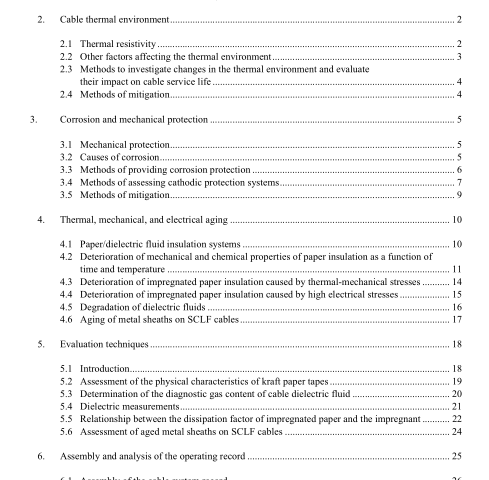IEEE 1425-2001 pdf download.IEEE Guide for the Evaluation of the Remaining Life of Impregnated Paper-Insulated Transmission Cable Systems
1.3 Unit conversion factors and acronyms
Metric units are used. Unit conversion factors are given in Annex B.
All acronyms used are defined at their first use.
All technical terms are as per IEEE definitions.
2. Cable thermal environment
The cable operating temperature is a direct function of its loading and of the thermal resistivity of surrounding soils (see AIEE Committee Report [B4], Mochlinski [B71], and Schmill [B91]). Although a cable operated continuously or frequently at loads exceeding its design limits will overheat even if the cable thermal environment is unchanged, changes to the environment in which a cable is placed may result in the cable operating at temperatures exceeding design temperatures. Overheating accelerates cable aging (see Kurtz [B66]) or forces cable derating (see AIEE Committee Report [B4]).
For the purpose of this discussion, the cable thermal environment includes, in the case of land cables, the backfill in which it is embedded, the surrounding soil, the surface cover, the water table, and the proximity to external heat sources. In the case of submarine cables, the marine environment and sediments in which the cables are placed have to be considered.
The cable environment can change with time due to either natural or man-made processes. This clause discusses changes in the cable thermal environment and the methods that could be used to mitigate harmful influences on cable service life.
2.1 Thermal resistivity
The thermal resistivity of the backfill in which cables are embedded, and that of the surrounding soils, are dependent on their moisture content or degree of saturation (see Radhakrishna, et al. [B88]). Figure 1 shows the dependency of thermal resistivity on moisture content for some typical soils and cable backfills (see Adams and Baljet [B1] and Radhakrishna, et al. [B88]).
Typically, the thermal resistivity can double or triple with the depletion of moisture content below a certain critical level (see Adams and Baljet [B1] and Radhakrishna, et al. [B88]), which leads to thermal instability (see Adams and Baljet [B1] and Radhakrishna [B86]) and cable overheating (see Arman, et al. [B11]).
Moisture content is governed by seasonal variations and changes in weather pattern, which determine how much moisture is delivered to the soil. However, this can be modified by excessive cable loading, which causes moisture migration away from the soils surrounding the cable. In addition, backfill thermal resistivity is dependent on other factors such as material composition and method of installation. Operating cables are often accessed for maintenance and repairs by excavating the backfill, or the backfill may be disturbed by construction activities. These disturbances may go undetected. If backfill reinstatement is not done properly, it can result in the development of areas of high thermal resistivity (hot spots), which over time could adversely affect the life of the cables. SCLF cables and HPGF cables, which have no intrinsic forced cooling facility to smooth the effect of hot spots, are especially susceptible.
In the case of submarine applications and in certain types of sediments, the heat from cables can cause thermal drying of the immediately surrounding material.
This drying can be severe enough, even when water depth is in the tens of meters, to result in thermal runaway (see Tulloch and Cronin [B96]). Also, there is a possibility in organic-rich sediments, of methane gas generation due to the heat from cables, which can impede heat dissipation and lead to cable overheating. The overall effect on the thermal performance of submarine cables should be evaluated by thermal testing of sediments along the cable route.
2.2 Other factors affecting the thermal environment
During a cable’s operating life, its thermal environment may change due to the growth of trees, the installation of other heat producing underground plants such as steam pipes or other power cables, the raising of grade elevations, the changing of the nature of soil cover, and excavations that are not properly reinstated.IEEE 1425 pdf download.IEEE 1425-2001 pdf download
IEEE 1425-2001 pdf download

Leave a Reply